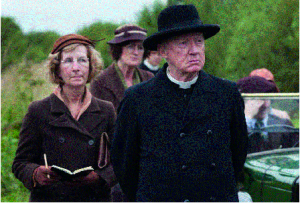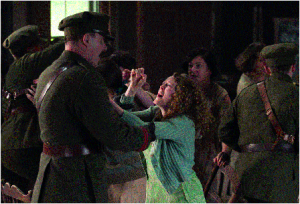Jimmy’s Hall
Published in Issue 5 (September/October), Reviews, Volume 22British director Ken Loach is well known for his cinematic accounts of fraught historical moments, dealing with the Spanish and Irish civil wars respectively in Land and freedom (1995) and The wind that shakes the barley (2006). In his latest outing he has turned his gaze to Ireland in the 1930s, a period when post-revolutionary cultural and political tensions were in the air. Scripted by Paul Laverty and based on a play by Donal Ó Kelly, such frictions in Irish society are dramatised through the life of Jim Gralton—socialist, small farmer and jazz dance promoter.
The view of Ireland in the 1930s presented in Jimmy’s Hall, familiar in some ways, is jarring in others. We can certainly recognise tropes that have registered in many films dealing with Ireland: the lush rural landscape, compromised clerics and energetic local disputes. In other ways, though, the audience is on less familiar territory. It is to Loach’s credit that he has made room for cracks in the mirror of dominant Irish histories, stories that run against the grain of more official narratives. A film dealing with Gralton’s complex contribution to Irish history could do no less. Luke Gibbons has commented that he ‘touched a raw nerve in the connective tissue of both Catholic and nationalist ideology’. Feeley’s seminal book The Gralton affair (1986) should also be mentioned at this juncture.

Jim Gralton (Barry Ward, centre) promoted a vibrant and notably pluralist popular culture that blended elements of Irish
and jazz music and dance.
For many Irish viewers, as well as an international audience that has perhaps grown accustomed to more familiar representations, the story will open up a more nuanced perspective on Irish history. Images of cattle-drives where the stock of ranchers is removed from their holdings by small farmers, of campaigns and marches to restore evicted tenants to their land, of a vibrant and notably pluralist popular culture that blended elements of Irish and jazz music and dance, of halls owned not by clergy but by local ‘committees’, of local farmers reading the Worker’s Voice: such depictions of life in Leitrim at this time are historically accurate and yet sidestep and undermine mythologies at every turn, digging away at the foundations of prescribed notions of ‘Ireland’ and ‘Irishness’.
Gralton was among the cultural and political innovators popularising what was initially termed ‘jazz’ music and dance in the 1920s and 1930s, and ‘modern’ in subsequent years. These terms referred to dances such as the quickstep and foxtrot that were initially popularised in the US and UK, as well as to the music that accompanied them. There is a memorable scene where Gralton, on his return from New York, unpacks a brand new gramophone and plays a jazz record before demonstrating some of the new moves to his young audience. The hedonistic energy of the dances that are soon held on a regular basis are beautifully captured in subsequent scenes, and correlate strongly with accounts of all-night jazz dances by participants interviewed in RTÉ’s Down with jazz (1987; available as a podcast on its ‘Documentary on One’ series).

We can certainly recognise tropes that have registered in many films dealing with Ireland: the lush rural landscape, compromised clerics (Jim Norton here) and energetic local disputes.
There is no doubt that Loach’s vision of dance in Ireland is far removed from the insular bleakness and tortured sexuality of RTÉ’s 1982 television production of William Trevor’s The ballroom of romance—another rare glimpse into Irish jazz dance culture. Loach’s politics, always well left of centre, are subtle and humane enough to encompass the joys of everyday life, of humour, sexuality and dancing. Gralton’s character (played by Barry Ward) is provided with some choice monologues along these lines. At the same time, it is not the case that the darker, more oppressive Ireland completely recedes from view, and there is no glib romanticising of rural life or of the past. From an early stage in the 1920s, and informed by Gralton’s establishment of the ‘Gowel Soviet’, Catholic clerics and cultural nationalists were synthesising ideas around ‘Bolshevism’, ‘pagans’, ‘Africans’ and ‘jazz’ into a sensational and compelling moral panic, a process that accelerated during the anti-communism of the 1930s. Currents such as these laid the basis for the anti-jazz campaign of 1933–4 in south Leitrim, but its repercussions were also felt nationally. There was a de facto ban on jazz on 2RN, the national broadcaster, between 1935 and 1945, and the enactment of the 1935 Public Dance Halls Act sought to tame what were perceived as the more exuberant aspects of the new dance culture. In Jimmy’s Hall these more conservative currents are personalised through the characters of the local priests, large landowners and Free State police.

Oppressive Ireland—personalised through the characters of the local priests, large landowners and Free State police and army.
And yet, in Loach’s production, the glass for a change is half-full. Instead of clerical victories, the dominance of cultural nationalism and a cowed, priest-ridden society, we are presented with the strength of a resistant ‘counter-community’ and its mass-mediated popular culture in south Leitrim. This is neatly captured in the final scene of Gralton’s departure (viewers can see for themselves the exact nature of this ‘departure’), where young dancers turn out to see him off and wish him well. Such dancers would carry forward the moves and aesthetics of the new popular culture. It is the case, for example, as recent research in Roscommon has demonstrated, that jazz music continued to boom throughout the 1940s and 1950s despite, and perhaps even because of, opposition from powerful conservative forces. In part owing to the actions of Jim Gralton, by the 1940s those infamous ‘sturdy youths’ and ‘comely maidens’ of de Valera’s imagination were far more likely to be found stepping out to the new sounds of jazz in their local hall. These shifts in popular culture would lay the basis for the showband boom of the 1960s, the discos of the 1970s and 1980s, and the club cultures of the 1990s and later. More broadly, we witness the seeds of a culture that sought its inspiration from outside the national territory and yet remained uniquely Irish.
Seán Shanagher lectures in cultural studies at Ballyfermot College of Further Education.
















